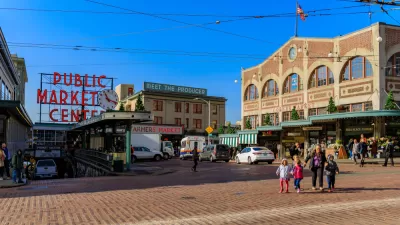Farmers Markets have exploded over the past decade. This phenomenon has not only brought more vegetables to cities but revitalization in the public.
Nothing quite says springtime like a farmer’s table loaded with kale, mustard greens, and spinach. And with the arrival of warmer days, soon communities will be enjoying the benefits of fresh, locally grown produce. Though farmers markets are often criticized over affordability and exclusivity, the appetite for them has grown significantly. In 1994, there were 1,700 markets nationwide; now, there are more than eight thousand. The proliferation of baby bok choy is indeed cause for praise. Markets help circulate dollars locally. More vegetables mean slimmer waistlines. And farmers markets can revitalize neighborhoods. These markets can also serve as a setting for what Jane Jacobs called the “sidewalk ballet,” a public space connecting people to each other. Their diverse functions—shopping, eating, or simply engaging neighbors—facilitate social interactions. In fact, the farmers market is unfortunately one of the few remaining civic places that facilitates such shared public encounters.
The decline of mixed public spaces can be traced back to the early twentieth century, when public officials began partitioning cities into areas based on functionality. At first, zoning was a public health initiative, especially in industrial cities plagued with unregulated pollution, rubbish disposal, and sewage handling. To keep factories and housing far apart, urban planners created restricted residential and industrial zones. However, a form of zoning logic, known as redlining, began to isolate populations of the city along lines of race and class. (The effects of redlining became more pronounced by the mid-twentieth century.) With the further help of the automobile and the suburbs, American cities became even more demographically and functionally divided.
FULL STORY: The Triumph of the Farmers Market

Alabama: Trump Terminates Settlements for Black Communities Harmed By Raw Sewage
Trump deemed the landmark civil rights agreement “illegal DEI and environmental justice policy.”

Study: Maui’s Plan to Convert Vacation Rentals to Long-Term Housing Could Cause Nearly $1 Billion Economic Loss
The plan would reduce visitor accommodation by 25% resulting in 1,900 jobs lost.

Planetizen Federal Action Tracker
A weekly monitor of how Trump’s orders and actions are impacting planners and planning in America.

Waymo Gets Permission to Map SF’s Market Street
If allowed to operate on the traffic-restricted street, Waymo’s autonomous taxis would have a leg up over ride-hailing competitors — and counter the city’s efforts to grow bike and pedestrian on the thoroughfare.

Parklet Symposium Highlights the Success of Shared Spaces
Parklets got a boost during the Covid-19 pandemic, when the concept was translated to outdoor dining programs that offered restaurants a lifeline during the shutdown.

Federal Homelessness Agency Places Entire Staff on Leave
The U.S. Interagency Council on Homelessness is the only federal agency dedicated to preventing and ending homelessness.
Urban Design for Planners 1: Software Tools
This six-course series explores essential urban design concepts using open source software and equips planners with the tools they need to participate fully in the urban design process.
Planning for Universal Design
Learn the tools for implementing Universal Design in planning regulations.
Caltrans
Smith Gee Studio
Institute for Housing and Urban Development Studies (IHS)
City of Grandview
Harvard GSD Executive Education
Toledo-Lucas County Plan Commissions
Salt Lake City
NYU Wagner Graduate School of Public Service



























